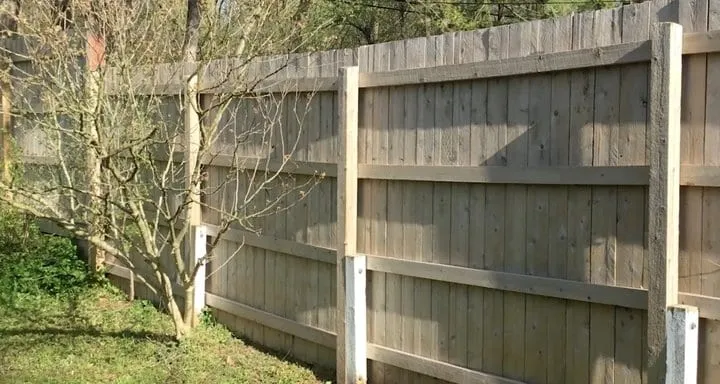Revive Your Fence and Boost Curb Appeal
Is your fence looking a little worn from the elements?
Are you ready to refresh your yard’s look with a beautiful, lasting finish?
Staining your fence can do wonders for its appearance, adding curb appeal, protecting it from weather damage, and prolonging its life.
In this guide, we’ll walk you through every step, from gathering the right tools to applying stain and ensuring a smooth, even finish.
Whether you’re new to DIY staining or just looking to refine your technique, you’ll find everything you need to achieve professional exterior staining results that make your Ann Arbor home stand out.
Tools and Materials You’ll Need
Having the right tools and materials is essential for a successful fence-staining project.
With quality tools, you’ll get better results, and the process will be easier to manage from start to finish.
Tools
- Stain Sprayer: A sprayer can help cover large areas quickly and provide an even coat, making it an efficient choice for bigger projects.
- Stain Brush and Small Roller: For detailed work and areas that need extra attention, a brush and small roller can help you apply stain evenly and reach tight corners. Follow the link to compare spray vs. brush painting to determine which is best for your project.
- Pressure Washer: Ideal for cleaning the fence prior to staining, removing dirt, mildew stains, and any loose stain from previous applications.
- Sandpaper or Orbital Sander (optional): Lightly sand rough or splintered areas to help the stain absorb better and ensure a smooth finish.
- Ladder (optional): For reaching higher sections of the fence safely and effectively.
- Drop Cloths and Painter’s Tape: Protect the ground, plants, and any nearby surfaces from overspray or stray drips.
- Safety Gear: Safety goggles, gloves, and a face mask to protect yourself from splashes and fumes.
Materials
- Exterior Stain: Choose a high-quality fence stain that matches the look you want, whether it’s a natural color or a more opaque finish.
- Deck Cleaner or Wood Cleaner: Use a cleaner designed for outdoor projects to remove dirt, mold, and mildew, preparing the fence for staining.
- Wood Filler: For filling holes, cracks, and other minor damages on the fence boards before staining.
With these tools and materials ready, you’ll be well-prepared to tackle your fence staining project and achieve a professional, lasting finish.
How to Stain a Fence: Step-by-Step Instructions
Staining a fence is a straightforward process, but following each step carefully is key to achieving a long-lasting, beautiful finish that protects your fence from the elements.
Below, we break down each stage to ensure your wood fence not only looks good but stays in top shape.
Step 1: Check the Weather
Before you start, review the weather forecast.
Staining requires specific conditions to ensure a smooth application and even drying:
- Ideal Temperature: Choose a day with mild temperatures, ideally between 50-80°F.
- Humidity Levels: Avoid days with high humidity, as it can prevent the stain from setting properly.
- Rain-Free Days: Make sure there’s no rain in the forecast for at least 24-48 hours after staining. This allows the stain to fully dry and absorb into the wood.
Step 2: Clear the Landscape Around the Fence
Preparing the area around your fence will keep nearby plants and outdoor furniture safe from stain splatters.
- Remove Obstacles: Move plants, decorations, and furniture at least three feet away from the fence.
- Protect with Drop Cloths: Lay down drop cloths to cover any surfaces you want to protect from stain drips or overspray.
Step 3: Inspect and Repair the Fence
Examine your wood fence closely for any areas that need attention before applying stain.
- Look for Damage: Check for cracks, holes, or loose nails that need to be secured.
- Make Repairs: Use wood filler to fill small cracks or holes. For rough spots, lightly sand with sandpaper for a smooth finish.
- Replace Damaged Boards: If any fence boards are too damaged, replace them to ensure a consistent appearance. Follow the link to see how we repaired rotting wood for client’s porch in Ann Arbor.
Step 4: Clean the Fence
A clean fence is essential for proper stain adhesion. Removing dirt and mildew stains will help the stain penetrate the wood evenly.
- Pressure Wash: Use a pressure washer to clean away dirt, mold, and mildew. Work carefully to avoid gouging the wood grain.
- Alternative Cleaner: If you don’t have a pressure washer, a garden hose with a stiff bristle brush and deck cleaner will also work well.
- Let It Dry: Allow ample time for the fence to dry completely before staining to prevent issues with absorption and finish.
Step 5: Sand the Fence (Optional)
Sanding isn’t always necessary, but it can improve the overall look and feel of your stained fence.
- Smooth Rough Areas: Use an orbital sander or sandpaper to smooth out any splintered or rough spots.
- Focus on Ends: Pay special attention to the end grain, which can soak up more stain. Sanding these areas helps ensure a uniform application.
Step 6: Mask the Area
Masking helps avoid accidental staining on adjacent surfaces.
- Use Painter’s Tape: Apply painter’s tape to edges or nearby surfaces that you want to protect. Follow the link for guidance on how to use painter’s tape.
- Cover Large Areas: Use drop cloths or plastic sheeting to cover plants, concrete, or other nearby surfaces.
Step 7: Stain the Vertical Posts
When beginning the staining process, start with the vertical posts to ensure even coverage and a consistent finish.
- Apply an Even Coat: Use a stain sprayer or a stain brush to apply an even coat, working from top to bottom to avoid lap marks.
- Spray Distance: If using a sprayer, hold the nozzle 6-8 inches away from the posts. This keeps the stain from pooling or streaking.
Step 8: Stain the Fence Boards
With the vertical posts completed, move on to the fence boards.
Following the wood grain while staining gives a professional, even look.
- Spray or Brush Along the Grain: Adjust the spray pattern to follow the grain direction. For vertical boards, use a horizontal spray pattern; for horizontal boards, use a vertical spray pattern.
- Back-Brushing Technique: After spraying, back-brush the stain with a brush. This step helps the stain penetrate deeply, especially in areas where wood grain might resist the stain.
- Using a Roller and Brush: If you don’t have a sprayer, apply stain with a roller on larger areas and use a brush to work the stain into smaller sections, edges, and corners.
Step 9: Allow the Stain to Dry
Patience during drying is crucial for a quality finish.
Allowing ample time to dry will prevent streaking and ensure the stain adheres well.
- Drying Time: Most fence stains need at least one hour to dry before applying a second coat, though the drying time may vary by brand. Check the manufacturer’s instructions for precise timing.
- Test for Dryness: Before moving on, touch a hidden area lightly to ensure it’s dry to the touch.
Step 10: Apply a Second Coat (Optional)
Applying a second coat can give your fence added durability and deeper color, especially if the wood has not been treated previously.
- Enhance Color and Protection: A second coat can intensify the color and boost UV protection, extending the life of your fence.
- Let Each Coat Dry Completely: Make sure the first coat has fully dried before starting the second. Repeat the process by applying stain along the grain and back-brushing as needed.
With these steps complete, your fence will have a fresh, professional look, enhanced durability, and a finish that complements your Ann Arbor landscape beautifully.
Case Study: How Tribble Painting Transformed a Worn Fence with Professional Staining

This case study highlights how Tribble Painting transformed a weathered, faded fence into a beautifully restored and protected part of the landscape.
Ann Arbor residents Jason and Sarah wanted to enhance their home’s curb appeal and protect their fence from further damage, but they knew they needed expert help for a lasting finish.
Background
Jason and Sarah’s wood fence had weathered over time, showing signs of aging with faded color and a rough surface.
They considered a DIY approach, but after weighing the time and effort needed, they decided to work with a professional company experienced in fence staining.
This decision gave them peace of mind, knowing the project would be handled efficiently and deliver the protection their wooden fence needed.
Solution: Tribble Painting’s Process for Fence Staining
Tribble Painting approached Jason and Sarah’s project with a systematic, professional method, ensuring both long-term protection and an appealing look for their fence.
Here’s how they achieved a remarkable finish:
Results and Client Satisfaction
After Tribble Painting completed the project, Jason and Sarah’s fence looked revitalized, enhancing their home’s curb appeal and providing added protection to the wood.
The couple was thrilled with the results and appreciated the professional approach that saved them both time and effort.
Revitalize Your Fence with Tribble Painting Company
While tackling this project yourself can be rewarding, sometimes leaving it to professionals ensures a flawless finish with less time and hassle.
Tribble Painting Company specializes in professional staining services, offering expert knowledge to protect your fence and create the perfect look for your home’s exterior.
If you’re ready to revitalize your fence with a professional touch, reach out to us today!
Fill out our contact form, or give us a call to schedule your consultation and let us bring your vision to life.

